Visiting Experimentarium, a science museum for young and old, is one of the best activities to do in Copenhagen with children. Experimentarium, as the name suggests, offers experiments on many scientific topics, from how shipping works to the physiology of the human body. The little ones can discover a Miniverse designed especially for them, with a farm, teddy bear hospital and enchanted forest. In this article, you can find out what to see and how to organise your family visit.
Table of Contents
What to see at Experimentarium, Copenhagen’s science museum
Experimentarium is so big that it is almost impossible to see everything in one day. Still, you can use this article as a guide to choose activities. The best section to visit is the harbour, where you can discover the economics and routes of sea transport, the human body and the Miniverse for young kids.
PLAN YOUR TRIP TO COPENHAGEN
Get the Copenhagen Card for free entry to 90+ museums and attractions, including the must-see Tivoli Gardens and canal tour, discounts in top-notch restaurants, and free transport by bus, metro, and train.
To stay connected in Copenhagen, buy an Airalo eSim online for phone and data coverage during your trip to Denmark.
The museum building is spectacular, with a huge central copper-coloured spiral staircase connecting all the visitor areas. The Experimentarium installations are updated periodically. You may find different activities compared to these.

Bubblearium: the science of soap bubbles
The Bubblearium is the area of the Experimentarium dedicated to soap bubbles. Here, you can create bubbles of all types and sizes. In the Bubblearium, you can make soap bubbles square or bigger than you and discover the science behind this game. As in all museum areas, you can choose to play or delve into the scientific aspects.
In the bubble-making area, you will find tools for creating bubbles of different sizes and shapes. Alternatively, you can step inside a soap bubble to experience what it is like to be inside it. At the light table in the workshop, you can examine the colours of soap bubbles and how they change as the liquid evaporates.
The Port: discover how maritime transport works
The Experimentarium’s harbour exhibition occupies 500 square metres and deals with the scientific and technical aspects of shipping by sea. In the Port area, you can discover how global trade, shipping and oil extraction works.
The most entertaining part is the giant marble track representing maritime transport routes. Through an interactive game, you can discover how goods are shipped worldwide economically and efficiently. You can play alone or with other people. You can work together and compete against each other to make the whole system work.
Younger children can still choose a ship and have fun moving goods around the marble track without activating the interactive installation. Even in this way, they can learn how goods travel worldwide before moving on to the area dedicated to sea travel and container ships.
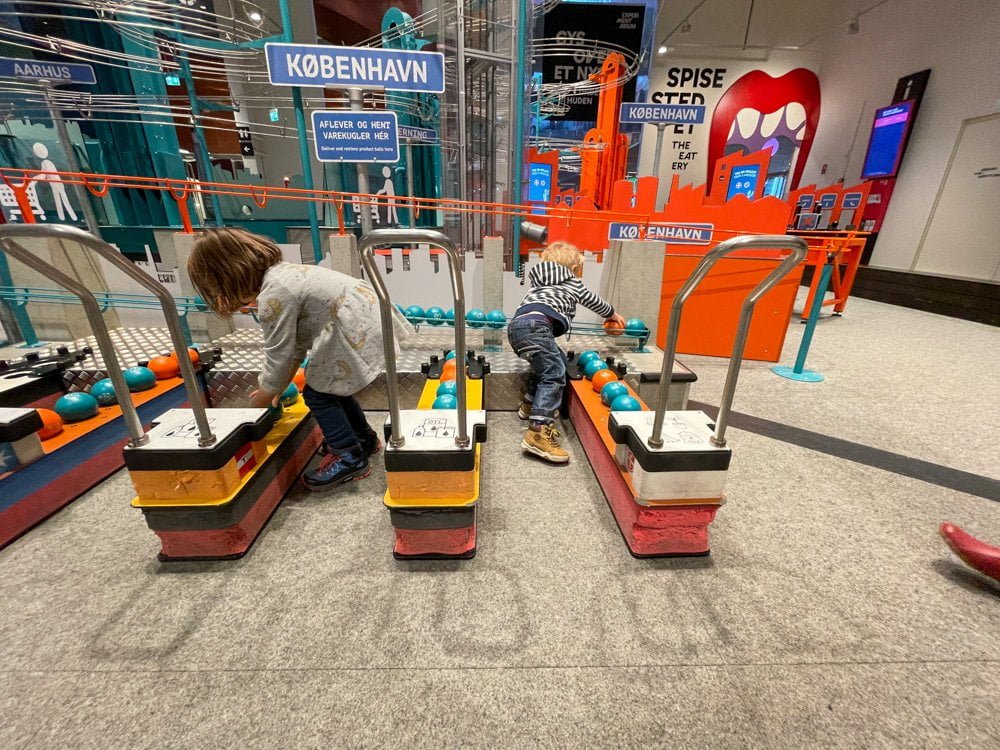
After moving goods wordwide, you can get on a simulator to sail the open sea and test your skills as a captain. My son really enjoyed this activity even though he let the castaways drown in a storm.
In the wind tunnel, you feel the force of a storm at sea. The wind blows with varying force against your body, while a video shows you what the sea looks like from the deck of a container ship in the North Atlantic Sea. Finally, you can learn about the offshore sector of the North Sea and how oil extraction works, with the differences between types of oil worldwide.
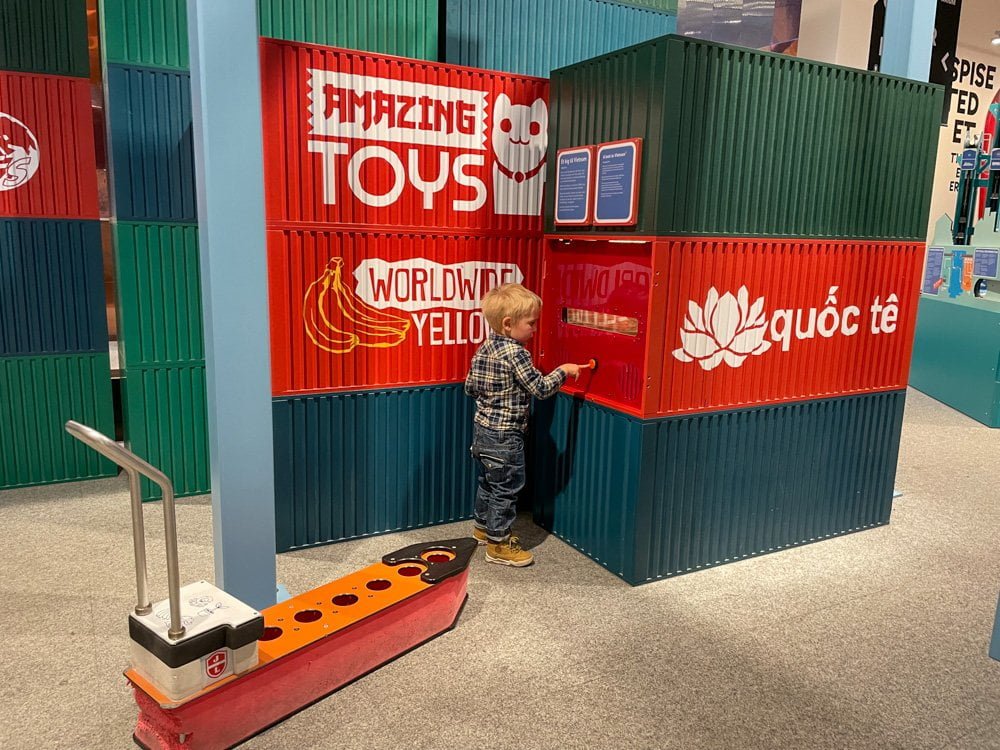
The Beach: learning to respect the sea
The Experimentarium’s route continues at the beach. Here, you can learn more about water, respect the sea, and discover what life along the coast can be like through simple science experiments. In this part of the exhibition, you will really find water, with tanks populated by ducks to push, waves to create and fish to catch.
Water exhibits like these are not very common in Italy. Still, you can find them everywhere in Northern Europe in children’s areas. There is no better way to discover the physical properties of water while having fun. There are many science games to try, from creating waves to balancing a ball on a waterspout.
Your child probably won’t stay dry, so roll up his sleeves and bring a spare T-shirt if they dive into one of the pools. This area also has dry games, such as fishing for rubbish you can find in the sea.
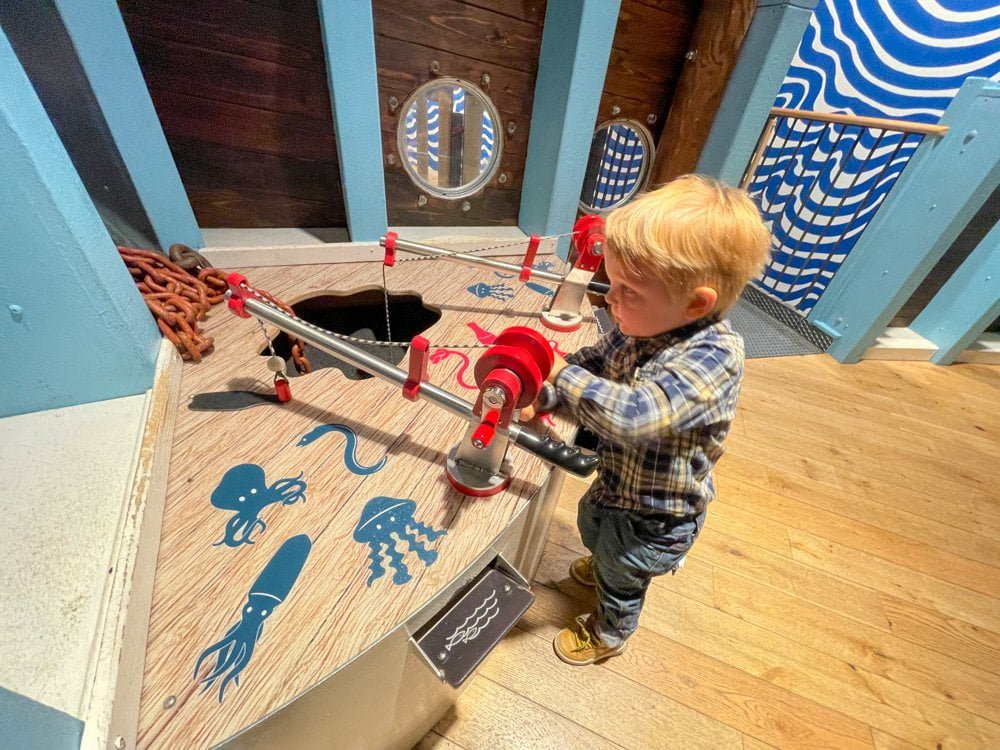
Under Your Skin: discovering how the human body works
The exhibition Under Your Skin takes you on a journey of discovering the human body. Here, you can experience and explore your body through fun educational experiments. You can listen to the sounds of your body, see what the brain looks like in 3D, fight an evil virus in the immune system game and observe your body through a thermal imaging camera.
There are four main activity areas:
- From the cell to the body
- Blood circulation: the body’s highway system
- Muscles and bones: the musculoskeletal system
- The brain: the body’s control centre
An enjoyable activity is to guess a sound of the body to find out how it works and how healthy it is. We usually don’t pay attention to it, but our body does make a lot of noise. For example, when breathing in and out, digesting food and when the heart beats.
In this area, you can try a step test to check if you’re fit. You can learn how good your body is at transporting oxygen to allow your muscles to work. Or you can watch the heat released by your body thanks to a heat-sensitive camera that shows the hot and cold spots on the surface of your body. The greater the blood flow to an area of skin, the warmer it is.
We liked the heartbeat station, where we could find out how our heart beats by holding our hands over the electrodes. I am sure you will enjoy Under Your Skin and the workings of the human body, even if this is not your favourite science subject.
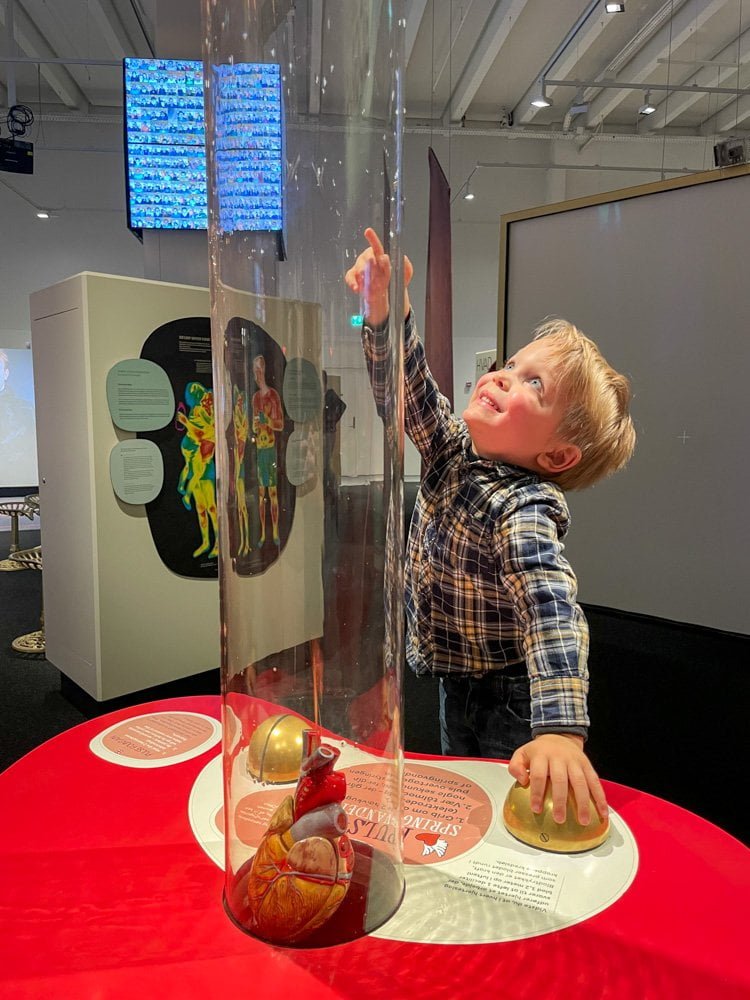
Miniverse: the science adventure for young visitors
The Miniverse is the area of the Experimentarium designed for children between the ages of 1 and 5. It is an adventurous world that stimulates the natural need to play and learn. Through seven separate areas, the little ones can approach science in a fun way.
In the Miniverse, children can construct buildings out of foam blocks that have to withstand the elements, explore a world of upside-down, doubled or even disappearing reflections, see how light and shadows behave when the sun goes down, feel the wind and experience how it pushes objects, care for teddy bears or collect fruit and vegetables on a farm.
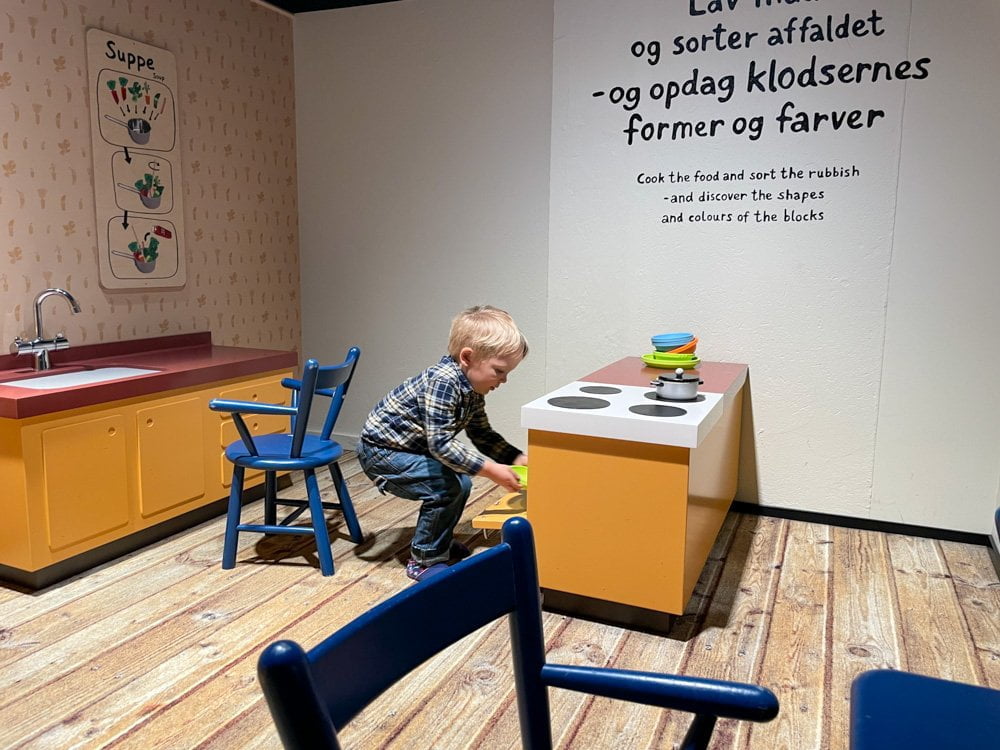
My son was three years old at the time of the visit and did not want to leave, heedless of the loudspeakers announcing the imminent closure of the museum.
Kids can collect eggs, fruit and vegetables on the farm, then cook the harvest or sell it in the farm shop. It is a classic children’s game but introduces a basic knowledge of mathematics and agriculture.
At the teddy bear hospital, children can take ‘x-rays’ of the teddy bears to see the skeleton and find out which bones are broken to know where to put the bandage in the right place. Visiting the teddy bears introduces the first elements of anatomy and helps children understand how the skeleton works and what it is used for. There are also lovely reading corners with books featuring Miniverse characters.
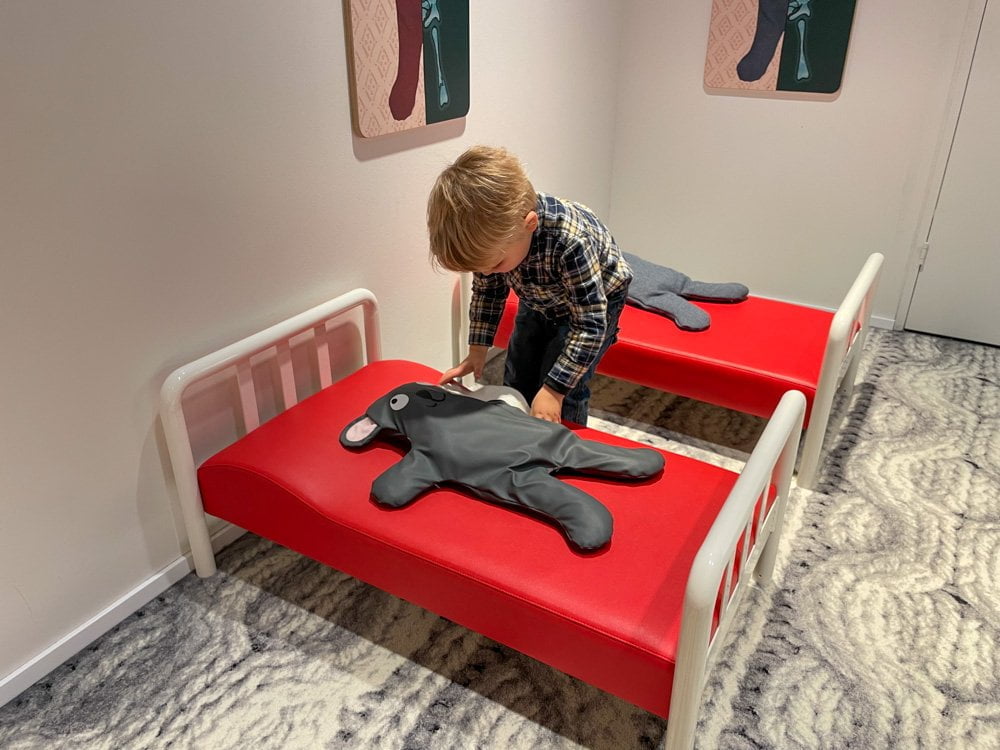
Experimentarium Copenhagen with children
Like all Denmark and Northern European countries, Copenhagen is easy to visit with children. Every exhibit in Experimentarium is child-friendly: you can touch and try everything. Your child can experience everything safely because the museum is designed for families.
Plus, the captions clearly explain the fundamental concepts of each exhibit. By trying and touching, you can learn how science works. Still, also grown-ups can have a lot of fun. My son and I have driven ships in storms and discovered how ports work and the differences between oil from the North Sea, Texas and Saudi Arabia.
The Experimentarium museum is really for everyone. In addition to the museum’s exhibitions, children from 1 to 5 years old can access the Miniverse, an area dedicated to toddlers, with activities designed especially for that age group.
Practical information for visiting Experimentarium in Copenhagen
Experimentarium is a vast science museum with many activities and temporary exhibitions. To organise your visit, you should decide in advance what you want to see so that you can devote most of your time to these exhibitions.
I recommend you arrive in the morning at opening time and spend the whole day exploring the Experimentarium, stopping for lunch in the museum’s restaurant or picnic area. This way, you can see all or most scientific exhibits.
As in all Danish museums, Experimentarium also has a cloakroom where you can leave your backpacks, jackets and bags to walk around the museum comfortably. The facility is fully accessible, so you can visit with a pram if your child is still small.
How much tickets cost
Tickets for the Experimentarium science museum cost DKK 215 per adult and DKK 135 for children aged 2 to 11. That is approximately €28 and €18 respectively. Very affordable annual passes are also available if you plan to return during the year because the temporary exhibits are renewed regularly.
The cheapest option, however, is to take advantage of the Copenhagen Card and entry for free. I recommend this option because the city card includes many Copenaghen attractions, such as the very popular and expensive Tivoli Gardens and the use of all public transport during the card’s validity period.
Eating at Experimentarium
If you spend a whole day at Experimentarium, you can stop and eat in the cafeteria. The museum has a restaurant and a picnic area with a playground for the little ones.
The restaurant has reasonably low prices by Danish standards and offers fish & chips, sandwiches, hot dogs, and chips. We tried hot dogs and fish & chips, which were good quality.
If you prefer to bring your food, the picnic area is right in front of the restaurant, with tables and chairs. The play area was a pleasant surprise as I was able to finish eating without rushing when my son ran off to play.
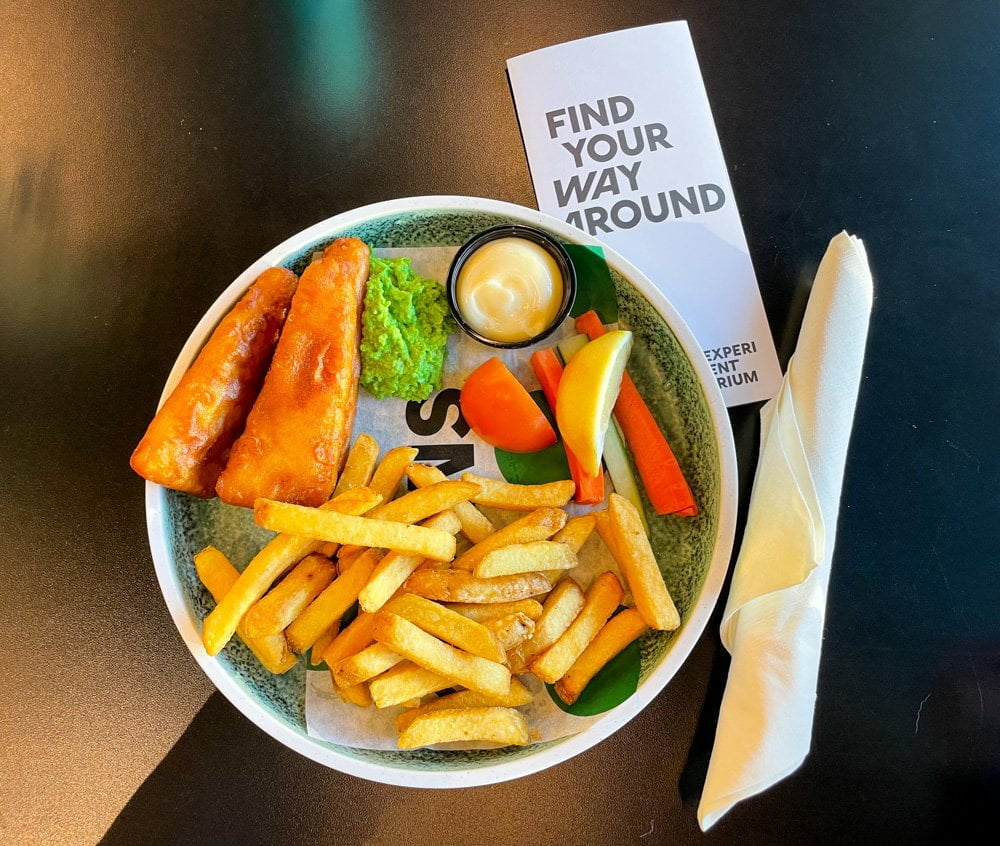
How to get to Experimentarium
The Experimentarium science museum is in Hellerup, a suburb of Copenhagen easily accessible by public transport. Several trains and buses depart from the city centre. The 1A bus stop is Tuborg Boulevard. If you choose the S train, you have to get off at Svanemøllen Station. The M3 metro’s closest stop to the museum is Trianglen.
To find the best combination of public transport from your hotel, check the route on Google Maps because it works very well in Copenhagen. With the Copenhagen Card, you can use any bus, train and metro in the whole Copenhagen area, including Hellerup. Otherwise, you can buy individual tickets or a daily city ticket at the machines at all metro stations to get around.
Experimentarium
Tuborg Havnevej, 7
2900 Hellerup – Copenaghen
Where to stay in Copenhagen
There are plenty of options for a Scandinavian-style stay in Copenhagen, including boutique hotels and designer flats. I stayed at Hotel Danmark by Brøchner Hotels, offering city views from its rooftop terrace. The 25hours Hotel Indre By is another recommended stylish hotel with a restaurant, bar, and sauna. If you’re on a budget, consider staying at Generator Copenhagen, a hostel with private rooms and dormitories, a late-night bar, and free Wi-Fi.
Experimentarium is one of the best experiences to have in Copenhagen with children. The city is fantastic, but this science museum is really exciting and fun, whether alone or with the family. The exhibits are all new, and you can learn while having fun. I suggest you dedicate at least one day of your trip to this museum. Feel free to share your thoughts about Experimentarium science museum in Copenhagen in the comment section.
